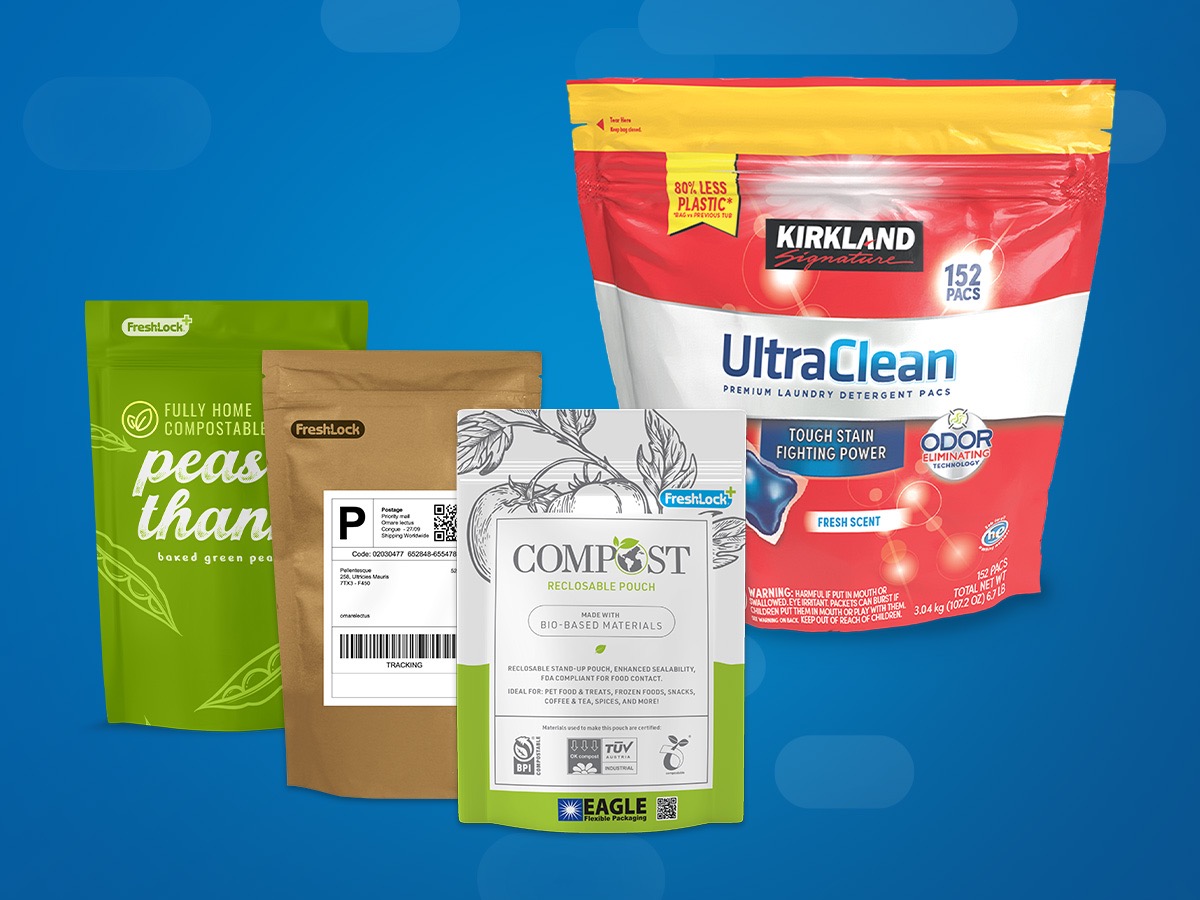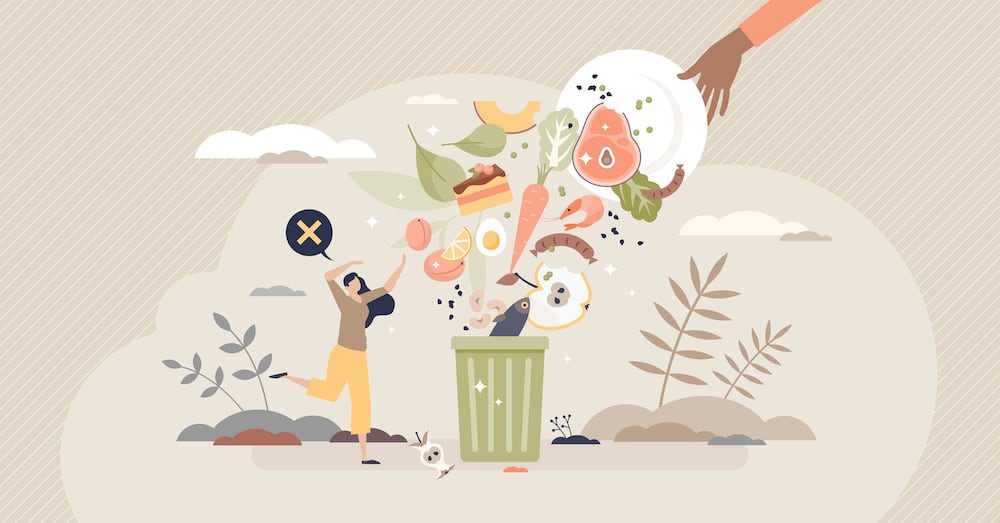
How Brands Can Help Reduce Food and Packaging Waste Post Purchase
The World Food Organization marked 2023 as a year of extreme jeopardy for food insecurity, with upwards of 345 million people—more than double that in 2020—expected to have struggled with hunger and malnutrition. Despite these staggering numbers, food waste and food-related packaging account for almost 45% of the landfill materials in the United States, according to the Environmental Protection Agency (EPA). This is not only a loss for those struggling to feed their families, but a great deal of resources used to produce, transport, process, and distribute the product is wasted, creating many long-term environmental impacts.
According to a Coresight Research study, 37% of food waste happens in consumers’ homes. Sadly, for many consumers, there is oftentimes no additional thought given to the waste from uneaten or spoiled food. A consumer buys a product, it expires, and they throw it away. But what they do not realize are the long-term impacts and costs associated with doing so. Since food manufacturers are unable to monitor the at-home use of consumer goods, addressing the issue becomes a collective responsibility to reduce packaging waste, food loss, and the pressing problem of food scarcity.
Packaging as a Solution
One approach to helping tackle post purchase food and food-related packaging waste lies in the hands of brands and packagers. By investing in packaging solutions that help ensure food and packaging materials don’t end up in a landfill, consumer-packaged goods (CPG) brands can play a pivotal role in helping curb excessive waste and food scarcity. Here are a few packaging considerations to keep in mind:
Help Extend Post-Purchase Shelf Life with Reclosable Packaging
In the pursuit of helping extend the post-purchase shelf life of products, a combination of proper package formats, effective films, and an efficient process can result in an advantageous packaging solution. Designed with quality-maintaining barriers, packaging can help protect the product from oxygen and moisture.
However, once a hermetically sealed package is opened, it loses its ability to maintain a modified or protected atmosphere. This opens the door to potential microbiological growth. Luckily, quality closures can play a crucial role in helping slow the exchange of air and moisture, simultaneously helping ensure product longevity, curb unnecessary waste, and eliminate the need for single-use bags or the repetitive cleaning of reusable containers. As a result, reclosable packaging becomes an ally for the processor, as well as a benefit for the consumer.
Opt for Sustainable Packaging Materials
As consumers prioritize solutions that keep the environment in mind, sustainable packaging materials emerge as a powerful weapon for combatting waste. For eco-minded consumers, sustainable packaging can have a big impact on their buying decisions. For example, some consumers may express ethical concerns about whether their coffee is sustainable or if the grower is environmentally conscious. But if the coffee packaging turns out to be a multi-material package that can’t be recycled or reused once the product is consumed, the consumer may have paid more for peace of mind that doesn't exist.
By investing in sustainable materials such as biodegradable plastics, paper, and materials that break down easily in the environment, brands can help reduce the burden packaging waste places on landfills and oceans. Similarly, with this movement toward incorporating more sustainable packaging, using mono-materials is becoming a common solution for packagers and brands—all while helping make it as easy as possible to add reclosability. The use of mono materials in packaging can also help increase likelihood that consumers participate in recycling programs, because there’s less work on the consumers part in determining which parts of a package should be separated at the time of disposal.
No matter the sustainable path a brand chooses—the adoption of sustainable packaging materials not only helps curb waste, but sends a powerful message to consumers, showcasing a brand’s commitment to environmental stewardship.
Right Size Packaging to Minimize Excess
In addition to embracing sustainable packaging materials, right-sizing can also help brands combat waste by reducing unnecessary materials in a package without compromising product safety.
Oftentimes, there are numerous layers of packaging consumers need to tackle before they can access the product. Excessive packaging not only frustrates environmentally conscious consumers that want to be more sustainable but can also create a needlessly complex and overwhelming experience. Right-sizing can help address these consumer frustrations, while simultaneously delivering ample benefits to the brand.
There are many benefits to right-sized packaging, including fewer costs associated with material procurement, production, storage, and transportation. By using fewer materials, brands can consume fewer resources and use less energy used to produce those materials. Furthermore, right size packaging helps reduce transport emissions because packaging is smaller and lighter. The net result is a smaller carbon footprint, less waste, and a better, less frustrating consumer experience. In essence, right-sizing packaging helps strike a balance between sustainability, cost-efficiency, and consumer satisfaction.
Support Consumer-Led Action
To help support consumer-led action, brands can aim to educate consumers on proper storage techniques and illustrate how food and food-related packaging waste signifies a far greater loss than the price of the product. By informing consumers about all the resources and energy used to make the product and it’s respective packaging, as well as the logistics of getting that product to a consumer’s home, consumers can make more informed decisions about their purchases and how they store products after the package is opened.
Adding a premium closure is a fantastic way to help communicate to consumers that the original packaging is best for continued storage of food products. Furthermore, when consumers keep products in the original packaging, the billboarding effect is preserved, allowing consumers to reference the branding and key information about when and where a product was produced, nutritional information, and who to contact with questions. As mentioned previously, a closure also helps eliminate the need for single-use bags or the repetitive cleaning of reusable containers in the consumer’s home.
Continuing Consumer Education Through Labeling
Outside of a brand's packaging design, featuring best-by dates and other important food packaging labels are necessary. It can be helpful for consumers when brands allow flexibility on the expiration date i.e., if it is passed the best-by date, the product may not be spoiled. There are also alternatives to best-by dates, such as freshness date and brewed-on date, that can still contribute to a consumer’s confidence when it comes to the product’s shelf life. Consumers may see value in more transparency on a food package such as ‘this package has been designed for this product,’ meaning the packaging has high significance in contributing to food protection.
Working Together to Help Reduce Food Waste
Designed to help keep food products safe and preserve freshness, functional flexible packaging can help provide consumers with the confidence necessary to return to trusted brands time and time again. So how can we strike a balance between helping protect the product for the consumer and reducing food and food-related packaging waste? The answer lies in fostering collaboration among brands, packagers, OEMs (Original Equipment Manufacturers), and film engineers. This collaborative effort is a vital step in helping promote sustainability and minimizing food waste post purchase. While many brands already have set standards and protocols for food safety, every participant in the supply chain needs to be accountable. Only through collective accountability and a shared commitment to eco-friendly packaging can we pave the way for a more sustainable future.
As we continue to move the flexible packaging industry forward with sustainable and reclosable features, we know that contributing to a circular economy helps make a difference. And working with industry partners creates better consumer experiences—one package at a time.
Looking to collaborate? Contact the Fresh-Lock team today.

 Back to Blog
Back to Blog


